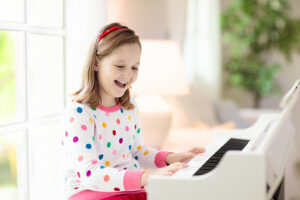
As a parent, one of the things you hope a teacher looks for when giving piano lessons in your home is how your child best learns the instrument. Part of the expertise of our teachers is to observe each student during lessons to best understand which methods resonate best with each student.
There are typically four learning modalities that suit students when taking piano lessons in your home. These modalities are visual, auditory, kinesthetic, and cognitive. Your child might not be aware of the way they best learn, so our team of dedicated and professional in-home piano teachers will help observe, understand, and adapt to each child’s unique learning style. Most likely, your child will utilize a combination of several, if not all modalities, in order to be successful during piano lessons in your home.
Visual Modality
Learning to play the piano is highly visual. Students must learn to read music, so it could be said that traditional piano lessons have typically benefited the visually inclined student more than students who learn best through other modalities.
If your child is a visual learner, they will likely be drawn to their sheet music, notice patterns within notation quickly, become confident sight-reading quickly, and they also probably like to keep their sheet music organized.
One downside to being a visual learner when learning the piano is that visual learners do not internalize learning music as quickly or as well as other students. This could mean that visual learners are slower to understand the pulse and expressiveness of a piece of music.
Auditory Modality
As opposed to visual learners, auditory learners approach music with a high internal understanding of music. However, they might struggle to know where to begin once they actually sit down at a piano.
Auditory learners are great at picking out melodies and tinkering around on the piano, not always knowing what notes or chords they are playing. They often get frustrated early on in learning the piano because they feel accomplished by learning to pick out music by ear, but then are forced into learning to sight-read, which is more challenging for them. Auditory learners typically hear music in their heads and are tenacious in recreating it on the piano. They may ask teachers to demonstrate something several times so they can make observations.
Kinesthetic Modality
Kinesthetic and tactile modalities focus on the act of physically touching the piano in order to learn how to play. While the kinesthetic and tactile are technically two different modalities as they refer to learning through large movements and fine motor skills, respectively, it’s easier to group them into one for this purpose.
When your child is taking piano lessons in your home, it’s important to notice if your child finds it helpful to sway or move to the music in order to understand the meter of the piece. They also might positively respond to the shape and feel of piano keys. Games and other activities that reinforce techniques they’ve learned are also key to positive learning experiences. Unlike auditory and visual learners, kinesthetic learners might have a harder time communicating their preferences for moving or clapping to the beat in order to internalize the music.
Cognitive Modality
While not technically a learning modality, many students do think about learning the piano, so it’s important to understand this component. While many students may roll their eyes at the idea of learning music theory, it is a critical part to truly excel at playing the piano. While auditory, visual, and kinesthetic learners will all approach learning music theory differently, you can pinpoint if your student is receptive to cognitive learning if they take an interest in knowing the meter of each piece, know the key signature of each piece, match the scale to the key signatures, understand how to build major, minor and seventh chords, and many more techniques like this.
All students are going to be on a spectrum of modalities, and they’ll never be totally efficient in one and totally deficient in another. The surest way to master the piano is to understand how to combine all of these modalities successfully when taking piano lessons in your home with our highly qualified instructors. They come right to your home for every lesson, plus we offer virtual music lessons, too. Our online music lessons are taught by local music teachers with live lessons tailored to your child!
